BenQ VW2420H Monitor Review
by Chris Heinonen on December 10, 2011 2:45 AM ESTViewing Angles and Color Quality
The BenQ uses a *VA panel (specifically A-MVA) and because of that the viewing angles on it are overall very good. You can get a bit of contrast shifting when you move to the extremes, but for all practical purposes there should be no real contrast shifts while working on it. Since this is designed just for desktop work and not for multiple people to use while gaming or watching TV, the viewing angles are very good.
When initially hooked up and set to 200 nits of light output, the average dE of the BenQ is in the high single digits, which unfortunately is very good for a consumer class LCD monitor—only higher quality professional (or at least prosumer) displays tend to be factory calibrated for accurate colors. The worst color is pure white, with the rest of the grayscale getting better as it gets darker, but overall this isn’t a monitor you would want to use for serious color work straight out of the box.
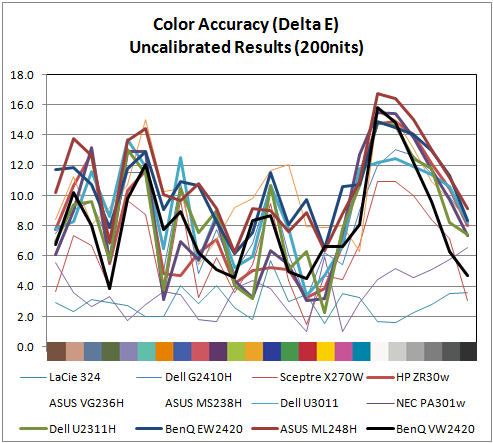
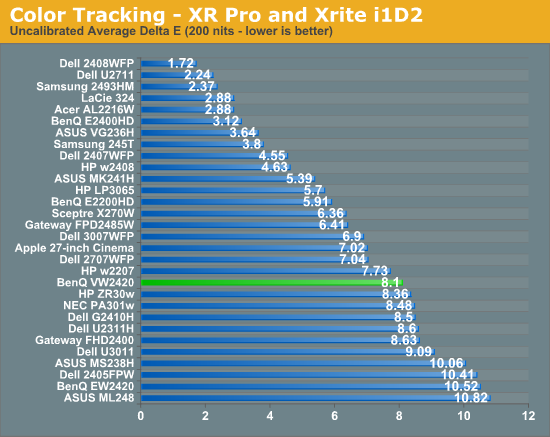
Of course, the uncalibrated results won’t be that important to people that care about color quality, since they would be calibrating the monitor regardless of the performance out of the box. In this case the BenQ performs well, though it's strictly average for a consumer display. Our average dE comes down to just about 2, and the majority of the grayscale is at 1 or below. The main errors are in the blue swatches that cause most displays issues, or fall outside of the sRGB colorspace. Calibrated the BenQ falls strictly in the “good, not exceptional” category for dE performance.
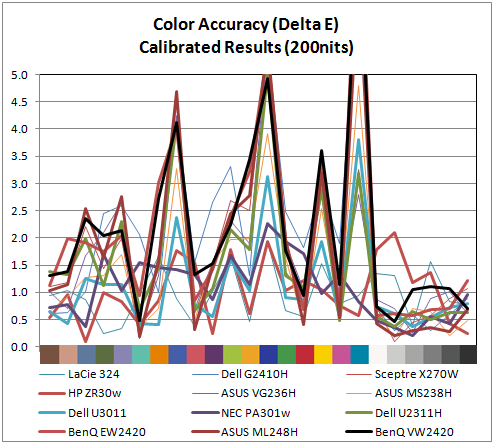
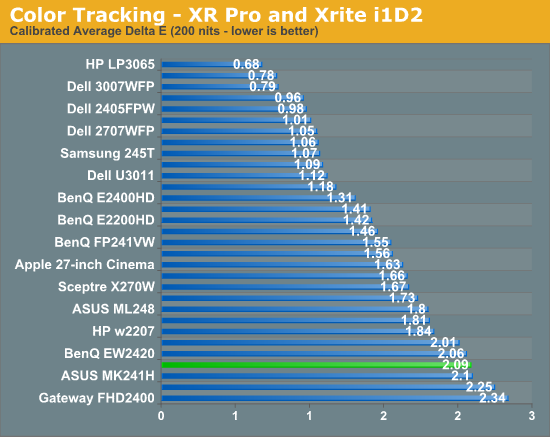
If you are doing print work and using a light output of closer to 100 nits than 200 nits, the performance of the BenQ is slightly better, but still in the range of most displays. The grayscale is more accurate which I like to see, and the color errors are in the same positions as before. If the 200 nits calibration data was close enough to accurate for you, then the 100 nits calibration data will be good enough as well, but the numbers are very similar.
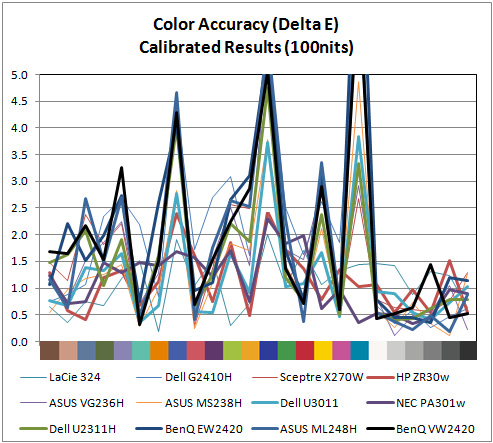
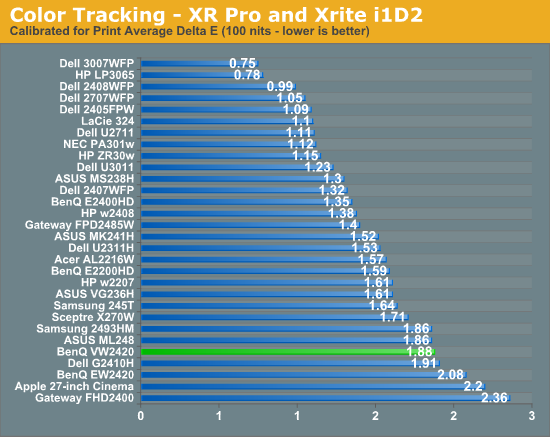










48 Comments
View All Comments
blueeyesm - Saturday, December 10, 2011 - link
"When initially hooked up and set to 200 nits of light output, the average dE of the BenQ is in the single digits, which unfortunately is very good for a consumer class LCD monitor."I think you may have meant "is not very good..."
Ryan Smith - Saturday, December 10, 2011 - link
Close. That was supposed to be "high single digits". Which actually is fairly good for a consumer LCD. It's only the professional LCDs that have good-to-decent accuracy out of the box.Samus - Saturday, December 10, 2011 - link
the last benq monitor i bought had an external power supply that failed twice before i finally ebay'd the monitor. as a credit to benq (a company with traditionally bad rap for support) they did replace the power supply both times, the second time being out of warranty! but the power supply ran super hot, and the monitor drew 160 watts from the wall when measured with a kill-a-watt.hopefully they've changed 'wall-wart' manufactures.
Rolphus - Sunday, December 11, 2011 - link
I've found BenQ's support to be excellent. I have an XL2410T that had a manufacturing defect (really bad light bleed on the right hand side), and getting it swapped out was extremely easy. I've also got a BenQ FP241W I use for work, and that has been very reliable, and with excellent picture quality.Neither of them use wall-warts for power: perhaps it's a component supply issue.
cheinonen - Sunday, December 11, 2011 - link
I will go clear that up, but yes, for a consumer display straight out of the box, anything below double digits is unfortunately considered to be good. The consumer video realm is finally getting to where displays and projectors have modes that are reasonably (dE < 5) accurate out of the box, so hopefully PC displays will get there as well.joelypolly - Saturday, December 10, 2011 - link
Lack of VESA mounts means that even though this is a pretty nice monitor it means that I won't be buying itMakaveli - Sunday, December 11, 2011 - link
"The main negatives for the BenQ in my book are the total lack of adjustments beyond tilt, which you can’t remedy with a different stand due to the lack of VESA mounting holes, and the OSD interface."Ditto for me also this would be a no buy just for this fact.
Goodjob Benq thanks for coming out.
psychobriggsy - Tuesday, December 13, 2011 - link
I've had this monitor for over a year now. Maybe it has just hit the US? I paid around £170 a year ago.It's extremely thin - which the review doesn't mention - and it uses a wall wart because of this.
It's a shame they didn't built the power supply and signal inputs into the base, as that would have been very tidy, instead cables hang out the back of the monitor (like any other) which rather lets down the point of creating a 'stylist monitor' in the first place, and losing VESA mounts, etc.
The picture quality is very good, for a consumer monitor, and far better than TN monitors in my opinion. Of course for serious gaming the TN monitors do have the fastest response times and the 3D options.
Torrijos - Saturday, December 10, 2011 - link
Black shiny edges are horrible for me...They reflect the light fixture directly into your eyes, incredibly annoying, I had to put tape on my last screen avoid the strain.
When are manufacturers going to understand buyers don't care about shiny just about functionality.
toyota - Saturday, December 10, 2011 - link
yeah bright shiny bezels are asinine for a monitor because they reflect everything around you. even the screen gets reflected on the inside edges of the bezel and that drives me nuts when playing a game or a movie.